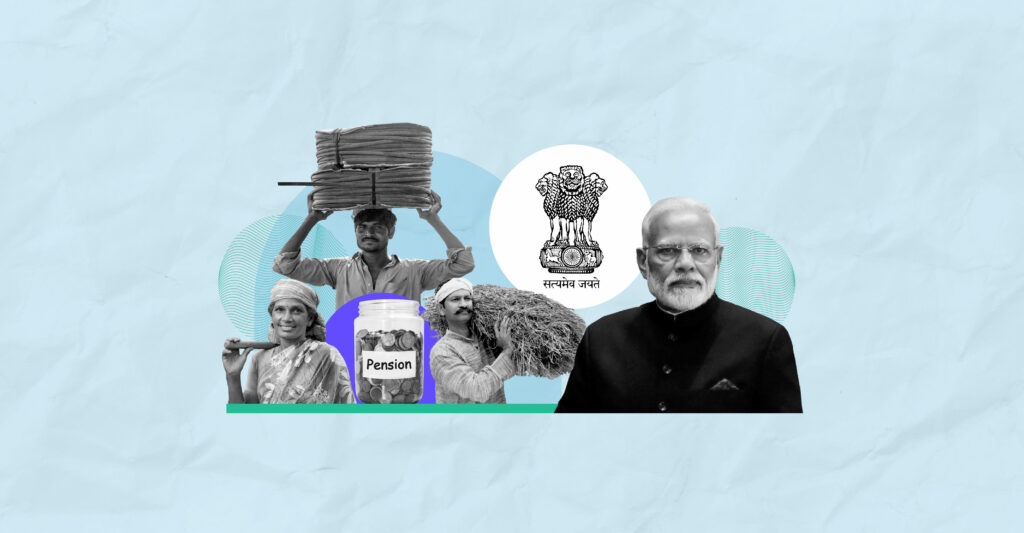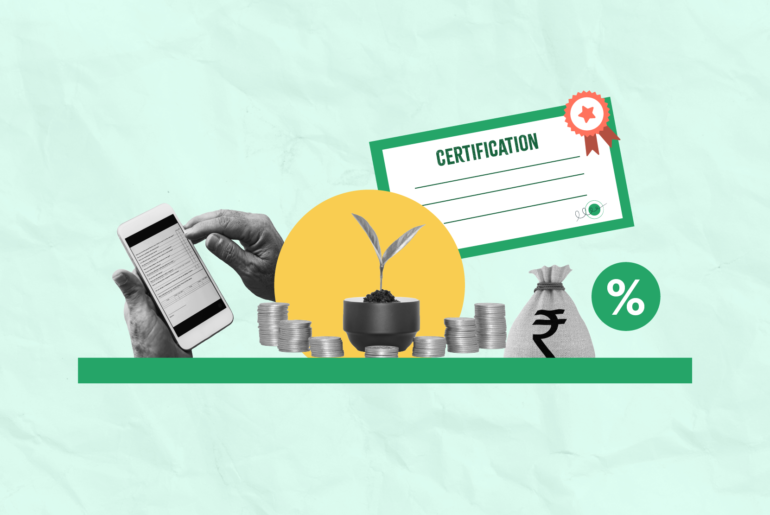Last Updated on Dec 6, 2024 by Aishika Banerjee
Pradhan Mantri Shram Yogi Mandhan (PMSYM) is a government-backed pension scheme to support Unorganised Workers(UW). This social initiative by the Ministry of Labour and Employment where eligible citizens should make monthly contributions to this scheme to get a pension after attaining the retirement age of 60 yrs. In this article, read about the PMSYM scheme, its features, eligibility, and more.
Table of Contents
What is PMSYM?
The PMSYM full form is Pradhan Mantri Shram Yogi Mandhan. It is a voluntary pension scheme for the labour class of 18 to 40 yrs. The subscribers need to make a regular contribution of Rs. 55 to Rs. 200 per month until they reach 60 yrs. After retirement, it offers a minimum pension of Rs. 3,000. The implementation will be through the Life Insurance Corporation of India (LIC) and PMSYM Common Services Centres (CSC). The LIC handles the payout of the pension.
Overview of PMSYM
| Interest rate | As per bank’s savings accounts interest rate |
| Minimum balance | Zero balance account |
| Age eligibility | 18 to 40 yrs |
| Minimum pension after retirement | Rs. 3,000 per month |
| Premature withdrawal facility | Available |
Features of PMSYM
The key features and benefits of the PMSYM are as follows:
1. Monthly contribution
A regular monthly contribution of Rs. 55 to Rs. 200 is made towards the PMSYM scheme. The contribution varies with the age of the contributor, as given below:
- For individuals of 18 yrs, the contribution is Rs. 55 per month
- For individuals of 29 yrs, the contribution is Rs. 100 per month
- For individuals of 40 yrs, the contribution is Rs. 200 per month
- Individuals above 40 yrs are ineligible for this scheme
In the PMSYM, the contributor and the central government make equal contributions. The contribution amount will be auto-debited from your bank account or the Jan Dhan account. Also, the maximum contribution cannot be more than Rs. 2,400 per year.
2. Pension amount
On attaining the age of 60 yrs, you will stop contributing to the scheme and get a pension of at least Rs. 3,000 per month.
3. The demise of the beneficiary
In this case, the contributor’s spouse will get 50% of the pension as a family pension. Only the spouse can receive the family pension, not the children.
4. Withdrawal
Due to the inconsistent nature of work in the unorganised sector, you can exit the scheme prematurely.
- If you exit the scheme within 10 yrs of the subscription, you will receive your contribution and the interest rate from the savings account.
- Suppose you exit the scheme after 10 yrs of the subscription (before 60 yrs of age). In that case, you will receive either the contribution with interest or the interest from the savings account (whichever is higher).
5. On disablement
If the regular contributor becomes permanently disabled before 60 yrs, the spouse is allowed to continue the scheme and make contributions. The spouse can exit the scheme by receiving either the contributions made with the interest or the interest as per the savings account rate (whichever is higher).
Benefits of PMSYM
The following benefits an individual can avail under the PMSYM scheme –
- A pension amount is provided to the individual after they attain the age of 60.
- The Government will contribute equally to the scheme as an individual based on the individual’s age.
- If an individual wants to opt out of the scheme before 10 yrs, the complete contribution made by the individual, along with interest accrued, will be given back to them.
- There is no need to maintain a balance. It is a zero-balance account.
Eligibility of PMSYM
The PMSYM scheme is for every worker in the unorganised sector. Street vendors, head loaders, handloom workers, rickshaw pullers, washermen, beedi workers, agricultural workers, domestic workers, construction workers, cobblers, leather workers, etc., are a few examples of unorganised sectors. In this sector, the monthly income depends on the worker’s daily work; hence, there are no fixed wages. As the workers don’t have a fixed income, they need to meet the PM Shram Yogi Mandhan Yojana eligibility criteria to avail themselves of the PM Shram Yogi Yojana benefits.
- You should be working in the unorganised sector.
- The entry age for this scheme is between 18 and 40 yrs.
- Your monthly income should be Rs. 15,000 or less than that.
- The subscriber should have an active mobile number and an Aadhar card.
- You must have a savings account or a Jan Dhan account.
Individuals who are tax-payers or engaged in the organised sector or are members of the Employees’ Provident Fund Organisation (EPFO), Employees’ State Insurance Corporation (ESIC), or National Pension System (NPS) are ineligible for the PMSYM scheme.
Contributions made towards PMSYM
The individual contributions to PMSYM shall be made through the ‘auto-debit’ facility from their savings bank account or Jan Dhan account. This PMSYM chart shows the PMSYM scheme details of entry age-specific monthly contributions –
| Entry Age | Superannuation age (Numbers of years of contribution) | Member’s monthly contribution (Rs.) | Central Govt’s monthly contribution (Rs.) | Total monthly contribution (Rs.) |
| A | B | C | D | (E)= (C)+(D) |
| 18 | 60 | 55 | 55 | 110 |
| 19 | 60 | 58 | 58 | 116 |
| 20 | 60 | 61 | 61 | 122 |
| 21 | 60 | 64 | 64 | 128 |
| 22 | 60 | 68 | 68 | 136 |
| 23 | 60 | 72 | 72 | 144 |
| 24 | 60 | 76 | 76 | 152 |
| 25 | 60 | 80 | 80 | 160 |
| 26 | 60 | 85 | 85 | 170 |
| 27 | 60 | 90 | 90 | 180 |
| 28 | 60 | 95 | 95 | 190 |
| 29 | 60 | 100 | 100 | 200 |
| 30 | 60 | 105 | 105 | 210 |
| 31 | 60 | 110 | 110 | 220 |
| 32 | 60 | 120 | 120 | 240 |
| 33 | 60 | 130 | 130 | 260 |
| 34 | 60 | 140 | 140 | 280 |
| 35 | 60 | 150 | 150 | 300 |
| 36 | 60 | 160 | 160 | 320 |
| 37 | 60 | 170 | 170 | 340 |
| 38 | 60 | 180 | 180 | 360 |
| 39 | 60 | 190 | 190 | 380 |
| 40 | 60 | 200 | 200 | 400 |
PMSYM registration process
There are two ways to register for the PMSYM scheme: self-registration or CSC. The self-registration can be done online, while offline registration can be done at the PMSYM CSC.
1. PMSYM registration steps through CSC (offline)
The eligible and interested individuals must visit the nearby PMSYM Common Services Centres. The list of the centres will be available on LIC or the Ministry of Labour and Employment websites. Carry the required documents and follow the steps given below to register for the PMSYM scheme:
- At the CSC, the Village Level Entrepreneur (VLE) will enter your name, Aadhaar number, and date of birth into their portal. All these details should align with the data available on the Aadhaar card for authentication.
- Once personal details are verified, you are required to provide other information like bank account details, mobile number, spouse and nominee details, and email address.
- The system will automatically calculate the monthly contribution according to your age.
- You need to pay the first contribution in cash.
- The VLE will provide the enrollment and auto-debit mandate form to sign. The signed form will be scanned and uploaded to the system.
- You will get the unique Shram Yogi Pension Account Number (SPAN) and a Pradhan Mantri Shram Yogi card.
2. PMSYM self-registration (online)
You can register for the PMSYM scheme online on the Ministry of Labour and Employment website. Follow these steps for the PMSYM online registration:
- Visit MAANDHAN website
- Click on self-enrollment
- Enter your mobile number on which you’ll be getting an OTP
- Once you log in, you will find several options like “new registration”, “incomplete enrollment”, and “complete enrollment”.
- Since you are registering for the first time, click on “New registration”
- Enter other details like the name of the applicant, Aadhar card number, address, mobile number, gender, date of birth, nominee details and bank details
- Once you fill in all the required details, you can apply and take a print of the same.
Documents required for PMSYM registration
- A savings account or Jan Dhan account details with an IFSC code. Take a copy of the bank passbook, bank statement, or cancelled cheque.
- Aadhar card
- An active mobile phone
- Carry some cash for the initial contribution
How to check the PMSYM balance?
You can conduct a PMSYM account balance check online on the UMANG website and follow the steps given.
- Visit the UMANG login portal
- Enter your registered mobile number
- You can log in through M-pin, or OTP received on your mobile
- Once you log in, you can find the PMSYM account balance and conduct a PMSYM account status check online for past transactions on the account.
In case of payment failure
If an individual fails to make contributions on a regular basis, they can regularise their contributions by paying the outstanding dues and fines (if levied by the government.)
In case of queries
To address any grievances related to the scheme, the individual can contact customer care at 1800 267 6888, which will be available 24/7. The web portal/app will also have the facility for registering complaints.
On a closing note
People living on daily wages may have a difficult time after retirement. Hence, with this government-backed scheme, they can look forward to brighter golden years ahead.
Frequently Asked Questions About PMSYM
1. Can we get a loan on the PMSYM scheme?
No. There is no loan facility provided on the PMSYM scheme. This scheme aims to financially support the labour class of the country at the time of retirement.
2. What happens if there are no regular contributions made to the PMSYM scheme?
In the case of irregular contributions, there will be a penalty charged. The monthly contribution and penalty will be auto-debited from your savings account.
3. Are the Pension Provident Fund (PPF) contributors eligible for the PMSYM scheme?
Yes. Pension Provident Fund contributors are eligible for the PMSYM scheme. But it is mandatory to meet the eligibility criteria of the PMSYM scheme to be a contributor.
4. Can we get the PMSYM card reprinted?
Yes. You can reprint the PMSYM card online on the UMANG website. Log in to the account with your registered mobile number and find the card reprint option on the portal.
5. Is the Aadhar card a mandatory document for the PMSYM scheme?
Yes. It is mandatory to have an Aadhar card for the applicant to subscribe to the PMSYM scheme as it is used to verify the applicant’s details.
6. What is the interest rate offered on the PMSYM scheme?
The interest rate offered on the PMSYM scheme is the bank-offered interest rate on your savings account.
7. What is the due date for the monthly contribution to the PMSYM scheme?
The enrollment date is considered the date of monthly contribution to the PMSYM scheme. However, the contributions to the PMSYM scheme are auto-debited from your savings or Jan Dhan account.
8. How to cancel the PMSYM scheme?
You can cancel the PMSYM scheme by visiting the nearby CSC or LIC office. Submit the scheme cancellation form along with the reason for cancellation. Once the account is closed, you can withdraw the funds (if any).
9. What is the PMSYM toll-free number?
The PMSYM customer care number is 1800 2676 888. It is a designated call centre to answer queries related to the scheme.
- Best Mutual Funds for Passive Investors (2025) - Dec 9, 2024
- List of Stocks With RSI Below 30 in India - Dec 9, 2024
- 10 Highest Dividend Paying Stocks in Nifty 50 NSE India - Dec 9, 2024




